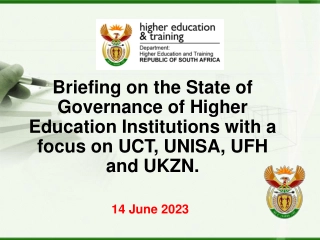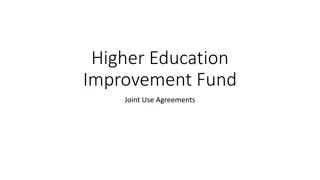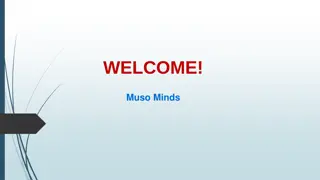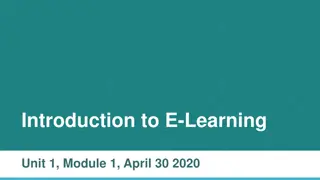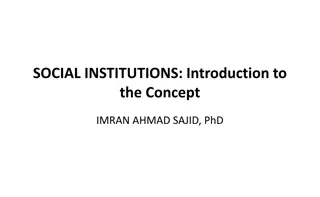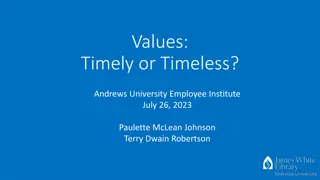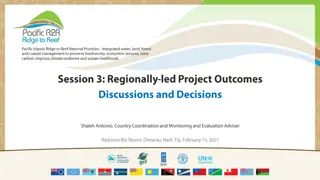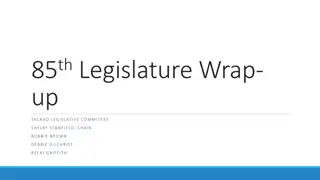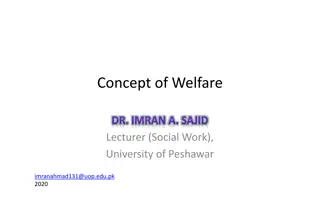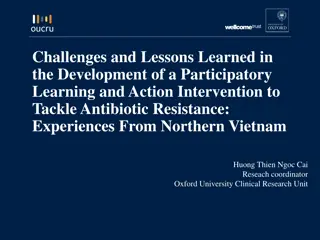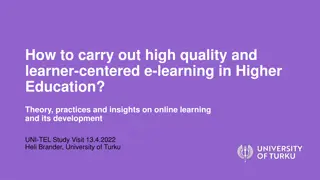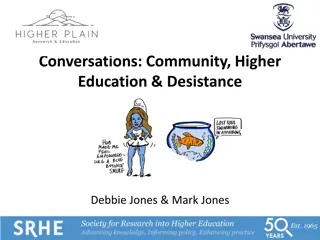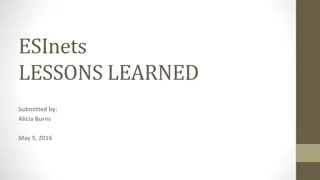Challenges and Opportunities of Transitioning to Online Learning in Higher Education Institutions: Lessons Learned from COVID-19
Economic researchers emphasize the role of education in economic development. The COVID-19 pandemic disrupted the education sector, causing a shift to online learning. This study explores the challenges and opportunities of moving from face-to-face to online learning in Rwandan higher education institutions, using a quantitative research design to analyze student perspectives.
Download Presentation

Please find below an Image/Link to download the presentation.
The content on the website is provided AS IS for your information and personal use only. It may not be sold, licensed, or shared on other websites without obtaining consent from the author.If you encounter any issues during the download, it is possible that the publisher has removed the file from their server.
You are allowed to download the files provided on this website for personal or commercial use, subject to the condition that they are used lawfully. All files are the property of their respective owners.
The content on the website is provided AS IS for your information and personal use only. It may not be sold, licensed, or shared on other websites without obtaining consent from the author.
E N D
Presentation Transcript
Challenges and opportunities of moving to online learning in the higher learning institutions: Lessons learnt during COVID-19 Pandemics By: Dr. Daniel Twesige and Dr. Faustin Gasheja
Introduction: Introduction: All economic researchers from the neoclassical to modern economist converge at one point that education is a key that unlocks the economic development of any country. One of the key variables in the estimation of economic growth is the supply of the labour. Education plays an important part in ensuring labour is supplied at the right time and in the right place
Introduction Contd Introduction Cont d COVID -19 Pandemic has not only affected the health system or the business sector of the country, but also affected the educational sector. Various researchers (Huston et al (2020) , Joseph et al., 2020, Bao, 2020 ..) have pointed out that COVID-19 affected the education sector in numerous ways such change in academic calendar, final year students unable to do research and internship, shift from face to face to online learning..
Rationale Rationale School closure is one of the non-pharmaceutical measures that were introduced to control the spread of Covid-19 Pandemic. In response to the covid -19 measures, many education institutions transferred from the normal face to face to online learning.
Rationale Contd Rationale Cont d As we moving towards a blended teaching and learning, what are the challenges and opportunities of the shift from face to face to the online learning Whereas literature on the challenges of moving from face to face to online learning has been established, little is still known in the Rwanda context
Methodology Methodology Design: The researchers adopted a quantitative research design Population: The target population was students from all higher learning institutions in Rwanda. 30 students were randomly selected Data collection: Primary data was collected using one set of questionnaire that was emailed to students through the class representative
Methodology Contd Data analysis: Descriptive and inferential statistics were used to analyse the data. Descriptive data was presented using frequency table Inferential data was conducted using ANOVA and the Kruskal Wallis test. The ANOVA test was used to test the significance of the challenges whereas the Kruskal Wallis test was used to rank the mean
Results and Discussion Online attendance of students Frequency Percent Valid Every day 309 28.1 Once a week 348 31.6 Twice a week 96 8.7 Three times a week 25 2.3 never attended 322 29.4 Total 1100 100.0
Challenges of online learning Rural areas Towns City of Kigali Lack of computers 75.6% 18.0% 6.4% Lack of enough skills to learn online 75.0% 65.0% 70.0% Lack of electricity 60.0% 25.0% 15.0% Un-conducive home environment 65.0% 70.2% 65.8% Lack of internet data 50.9% 36.8% 12.3% Poor internet connections 79.6% 41.1% 39.3% Studying without exams 78.0% 62.0% 80.0%
Table 5: Ranks of the most affected students Location N Mean Rank Challenges faced Rural Areas 479 189.44 during the online learning Towns 334 158.03 City of Kigali 131.38 287 Total 1100
Table 6: Test Statisticsa,b Challenges faced during the online learning Chi-Square 21.049 df 2 Asymp. Sig. .000 a. Kruskal Wallis Test
Significance test of the Impact of online Significance test of the Impact of online learning on the Learning Process using ANOVA learning on the Learning Process using ANOVA F Sig .000 Reduction in the maintenance costs Affected the quality of learning Lack of face to face clarification Studying without exams Promoted independent learning Lack of group discussions 27.740 3.591 9.310 1.850 6.437 1.973 .029 .000 .276 .002 .141
Conclusion and policy recommendations Conclusion The shift from face to face to online learning has both positive and negative but the negatives outweigh the positive impacts. Learning inequality among students due to poor network connections, lack of data, lack of electricity, lack of learning infrastructures. The positive impact of the shift included promotion of independent learning by the students; maintenance cost of students during the learning process and improved the technological skills of the students.
Policy Recommendations Policy Recommendations Closing the learning inequality gap that has been created among the students in towns, cities of Kigali and those from the rural areas due to poor internet connections in the rural areas. Education institutions should train the students on online learning. A module should be introduced in the first year that introduces to students the online learning. Education institutions should revise their investment model from physical assets to technology



